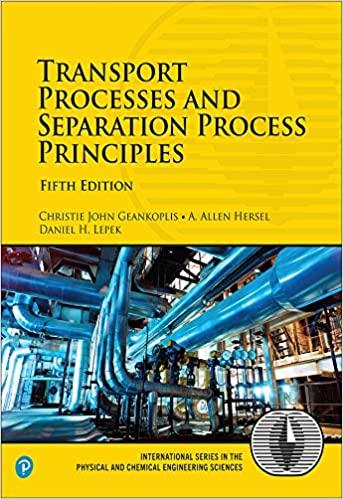Answered step by step
Verified Expert Solution
Question
1 Approved Answer
Exercise 2 Since fuorinated working fluids have been banned in the EU since 2 0 1 1 , several altematives are currently being investigated for
Exercise
Since fuorinated working fluids have been banned in the EU since several altematives are currently being investigated for use in ORC Organic Rankine Cycle systems. One alternative is supercritical In this process, subcritical is compressed to a supercritical pressure. Heat is added to the supercritical working fluid. In the turbine, the is expanded back to subcritical pressure and the waste heat is removed. Figure shows the plant process diagram.
Figure : Process Diagram of the ORC Systems
The individual processes of the ORC system can be calculated as follows:
Isentropic Compression
: Isobaric Heat Intake
: Isentropic Expansion
: Isobaric Heat Outtake
The critical State of is given by:
MPa
The lowpressure states have a pressure of bar and are thus in the subcriti range. In contrast, the pressure of the highpressure states is bar and is th supercritical range. Accordingly, the ideal gas law cannot be used for the calcul
Therefore, perform the calculation using the Van der Waals equation:
Here is the molar Volume and the general Gas Constant:
a Berive relationship between Van der Waals parameter a and b and critical quantey A thi lite molar eritical volume Exploit that the critical point is the saddle point the eritical isotherms of the Van der Waals equation.
b Calculate und for
State corresponds to the state of the saturated liquid and state corresponds to the state of the saturated vapor. Thus, the states are on the same isotherm for : K If these values are substituted into the Van der Waals equation and the molar volume determined, solutions are obtained:
saturated liquid
saturated vapor
c Using these values and Maxwell's construction, show that is a good approximation for the saturation temperature for the pressure of
The change of the molar Entropy for a process of a Van der Waals gas is given by:
The molar heat capacity is calculated via:
d The isentropic compression from the state to the state results in a tempt of From this, calculate the molar volume in the state.
The change the molar internal energy of a Van der Waals gas is given by:
e Finally, isobaric heat addition yields the state : Calculate the molar heat added.

Step by Step Solution
There are 3 Steps involved in it
Step: 1

Get Instant Access to Expert-Tailored Solutions
See step-by-step solutions with expert insights and AI powered tools for academic success
Step: 2

Step: 3

Ace Your Homework with AI
Get the answers you need in no time with our AI-driven, step-by-step assistance
Get Started


